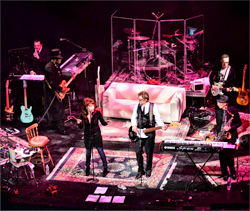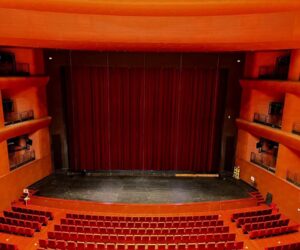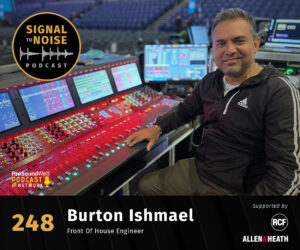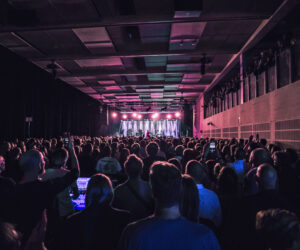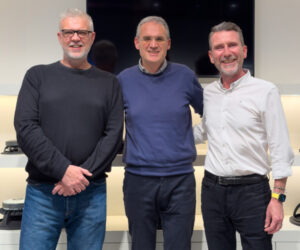Audio Logic Systems of Minneapolis, which recently celebrated its 20th anniversary, provided production for a major concert event at the historic Loring Theater that featured the reunion of four of The Family’s original members—“St. Paul” Peterson, Jellybean Johnson, Susannah Melvoin and Eric Leeds—after nearly three decades apart.
After debuting in 1986, The Family’s self-titled, Prince-produced album received positive reviews (and produced the single, ‘Nothing Compares 2 U’, famously covered by Sinead O’Connor). But after a single, sell-out show at First Avenue, they went their separate ways. The Loring concert saw the group re-emerge under the new name of fDeluxe and celebrating the release of a new CD entitled Gaslight.”
Audio Logic owner John Markiewicz and systems tech Ed Coutu brought in a full d&b audiotechnik system comprised of J-SUBs, J Infra Subs and C7 mid-high cabs, Q10 front fills, with d&b M6 wedges, plus two DiGiCo consoles—an SD8 at front of house and an SD10—for handling the group’s wedges and in-ear monitoring systems.
Since 2009, the company has purchased three DiGiCo consoles, with plans for adding a fourth in the coming year. “At Audio Logic, we take pride in the sound systems we use in production, and the union of the DiGiCo desk, whose sound quality is second to none, into the phenomenally sounding d&b audiotechnik systems is a marriage made in heaven,” Markiewicz says. “We don’t even use drive racks anymore, we just go straight out of the desk through AES directly into the amps—there’s nothing in between—and our sound quality is just fantastic.”
Initially the input list was quite large with provisions for the 7-piece band—which included the core Family members, plus guitarist Oliver Leiber, Jason-Peterson DeLaire on keys/sax, and drummer Mario Dawson—in addition to a 6-piece string section. In the end, it was decided that the inputs needed to be scaled back to a manageable 46.
“The initial stage set called for two drums sets because original drummer Jellybean Johnson (playing bass in the new band) was left-handed and wanted to sit in on a few songs,” explained Markiewicz. “As things got scaled back, we were only able to use one drum set, with the tech switching kits back and forth on those songs… Which were not played in sequence.”
“On top of that, I found out a day-and-a-half before the show that KTCA, the Minnesota public TV station, had plans to record the show, so there was the addition of a few extra mics added for that. We agreed that since we were already tracking the show at FOH using an RME MADIFace we could simply split the feed. I set up KTCA’s engineer, Joe Demko, with a mono feed from my console to sync up in post, which would give them more control over the quality of it. Post mix engineer Brian ‘Snowman’ Powers was given an additional MADIface interface in monitor world and he tracked the whole show there.”
Perhaps one of the biggest save-the-day features for Markiewicz was the ability to do the virtual sound check. “Going into this, I knew it would be a show that we’d have to fly by the seat of our pants on,” he notes. “The venue was fairly small and the group was very large and I thought it was best to put everybody on in-ear monitors. Because of budgets, we weren’t able to provide full production for rehearsals, so mixing FOH was going to be very much on the fly on the day of the show.
“When it was mentioned that Scott Fahey would be doing monitors I was thrilled; he’s an absolutely phenomenal engineer. I decided to give him the SD10 for rehearsals, which is an excellent desk to mix in-ears on. By getting him the console early, he was able to mix the ears and whatever wedges we ended up using and I was then able to take his preamp settings and recorded tracks and do a quick virtual soundcheck on my own back at the shop on an SD8. I was able to build scenes for the individual songs, and set up a fair amount of things so that I could get through the show as easily as possible without the benefit of a full production rehearsal.
“When I got the set list on Friday at load-in, I was able to put the scenes in order, set things such as my gates from song to song, Gain-Track off what Scott got at rehearsals and it allowed me to fine tune each song. It gave me a leg up so when I heard the songs for the first time on the night of the show, I was 80 percent there. And quite literally, it flew from there. We stepped into sound check, ran through 3-4 of the songs, and next thing you know, we were into the show. The virtual soundcheck feature really saved my butt on this show, and I think it’s one of the best features of the console, period.”
At monitor world, Fahey came into the gig with no experience on a DiGiCo console, but the former production manager for the Gatlin Brothers club at the Mall of America currently lead audio engineer at Living Word Christian Center, was overly impressed with the sound and layout of the SD10. “I loved the way it sounded overall, the EQs were clean and it was very responsive. When I turned a knob it did what I wanted it to do. I downloaded the offline software and spent some time on that so that when I got in front of the console I’d have a general idea how it worked. After that, I was able to get some hands-on time at the Audio Logic shop.”
“The DiGiCo consoles gave me the tools I needed to do this show,” Markiewicz adds. “This was not a show where we were going to have time to chase down problems. We needed to keep it as clean and neat as possible, not having to use a splitter snake, having the MADIface and multitracking capabilities, all that stuff, is directly related to what I can do with the DiGiCo desks. Walking into an event like this, we all knew we’d have to make it happen rather quickly and work together. And that’s exactly what happened.”


